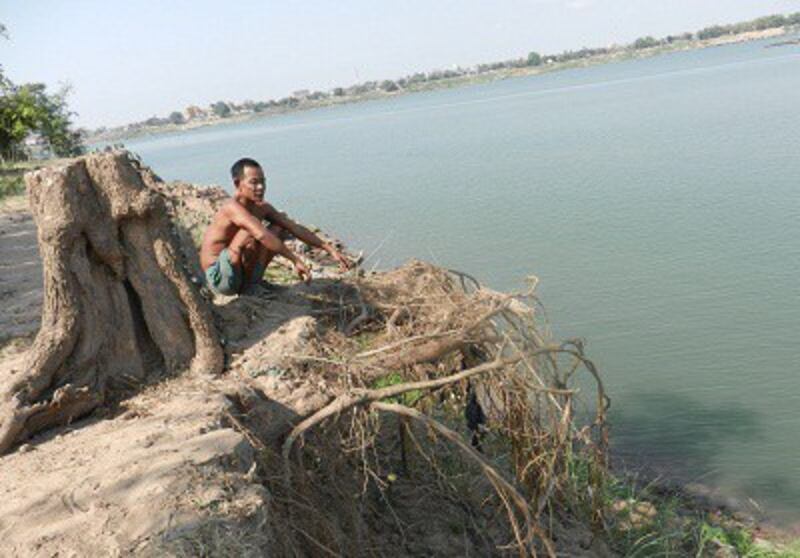Villagers who live along the banks of the Mekong River in Cambodia’s eastern Kampong Cham province say that sand dredging by a private company is threatening their homes.
The land on which their houses are built is collapsing into the river because of the dredging, they say, as a Vietnamese company mines the river’s sand for use in a nearby construction project.
But local authorities have rejected any notion that sand extraction is causing the land loss, saying strong river currents are eroding the land instead.
The villagers in Tboung Khmum district, where most houses are built along the water, have been forced to move at least 70 of their houses to avoid danger from the riverbank collapsing.
One villager, Kong Chamroeun, said that the company has been dredging sand since early 2011 and that the riverbank is now starting to collapse into the river.
“We are moving because we know the danger. The water is flowing fast and the riverbank is collapsing,” he said.
“The more sand is dredged, the more the riverbank is going to collapse. The riverbank rarely collapses without the sand dredging,” he said.
Another villager echoed her concern.
“Villagers have moved to a nearby location or live with their relatives,” she said.
Cambodia has struggled with the environmental cost of sand mining from its rivers, as private businesses get licenses from local government to dig up sand from riverbeds and use it for commercial projects.

Loans
The villagers who have lost their land to the river are borrowing from the bank to lease land to build houses.
Chirou Ti Muoy Commune Chief Long Yet said that about 60 percent of the villagers in his commune took loans from banks because they have moved to a new location.
“We are concerned. When I asked the company, they said that they are dredging the sand to allow water to flow,” he said.
He added that the riverbed is shallow, and since 2011, some areas of the riverbank have collapsed between 70 meters to 100 meters (230 to 330 feet).
Villagers said the dug-up sand is being used to fill the 130-hectare (320 acre) Boeung Snai lake in a residential project in the city of Kampong Cham, where a private company has been hired to build a satellite city to expand the city.
Governor
Provincial Governor Hun Neang denied that the riverbank collapse is caused by the sand dredging.
He blamed the collapse of the riverbank on excessive water flowing during the current dry season.
“Before the sand dredging, the riverbank also used to collapse. In my hometown, houses and a pagoda fell into the river,” he said.
The governor, who is Prime Minister Hun Sen’s brother, added that the authorities are working to provide land to the villagers to rebuild their houses.
“I am requesting that the prime minister provide 80 families whose houses have collapsed with relocation sites,” he said.
Cambodia has grappled with the environmental cost of sand dredging for years.
In 2009, the government banned sand exports after dredging on the Tatai River in southwestern Cambodia’s Koh Kong province and sold to Singapore for land reclamation triggered international controversy.
Continued dredging after the ban sparked protests later that year among locals concerned about damage to fish stocks and ecotourism projects.
A 2010 report from the U.K.- and U.S.-based environmental group Global Witness estimated that some some 796,000 tons of sand per month were dug up in Koh Kong province alone, including in protected wildlife areas.
Last month, the Ministry of Water Resources and Meteorology said it was moving forward with plans to dredge sand from the Mekong River and its Bassac River branch in southeastern Cambodia to expand navigation channels for shipping trade.
Reported by Zakariya Tin for RFA’s Khmer service. Translated by Samean Yun. Written in English by Rachel Vandenbrink.
